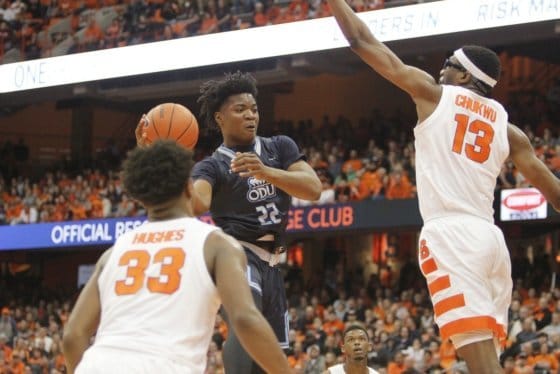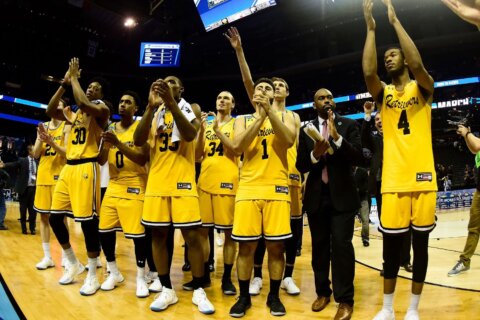Last year, I sat down midseason to write about Virginia, the top team in the country, riding along with a single loss atop the ACC. They were taking on a decent but not great Virginia Tech team at home, where they were a spotless 14-0. This was a chance to see them do what they do best, suffocate a high-powered offense with their smothering pack line defense and grind their way to another win, a chance to measure up their chances at finally breaking through to the Final Four and winning a national championship.
So, of course, the Cavaliers lost, in overtime.
It was a harbinger, perhaps, of a much more publicized loss five weeks later, the one nobody in Catonsville or Charlottesville or anywhere else people watch college basketball will ever forget. But now, heading into the final weekend of the conference tournaments, Virginia’s back, almost certainly assured of the top overall seed in the NCAA Tournament once more.
They’ve only lost to one team all year, a full strength Duke squad. Of their 29 wins, only one has come by fewer than five points. But all these things will only make the echoes of last year’s historical upset louder over the next week.
That UMBC game looked a lot like the Virginia Tech game earlier in the year. The Hoos trudged along through a defensive, lackluster first half against the Hokies, scoring just 26 points and trailing at the break. Against the Retrievers, they put up just 21 points before the half.
Virginia’s painfully deliberate style — they rank among the top 10 teams in average length of possession on both ends of the ball for the third time in the last four years — intentionally shortens games and heightens the pressure on each possession. The Cavaliers are happy to live this way, but in so doing, they amplify the power of the three-point shot, both for and against themselves.
The Hokies hit 11 threes on 38 percent shooting from behind the arc; UMBC hit 12 of their 24 three-pointers. Only twice this year has an opponent reached double figures in shots made beyond the arc. Duke shot a preposterous 13-21 (62 percent) in its February win, and Louisville leaned in fully, taking 33 of its 55 shots from deep back on Feb. 23. They made 12 triples, but shot only 5-22 inside the arc in a 12-point UVa. win.
Tony Bennett’s team is built this way, and it will continue to dare teams to beat it from behind the arc. But the Cavaliers are also using the three to their advantage more shrewdly than ever this season. While Virginia is an excellent three-point shooting team — second in the nation — the Cavaliers don’t rely on the deep ball in the way that flawed, early exiting top seeds of yore have.
Virginia is now 2nd nationally in 3P% but only 176th in 3PA rate.
— Ken Pomeroy (@kenpomeroy) March 14, 2019
This is Bennett’s sharpest-shooting squad ever, even better than the 2016 edition with Malcolm Brogdon and London Perrantes (40.2 percent, 10th in the country). UVa.’ s top three volume three-point shooters are Kyle Guy (46.4 percent), Ty Jerome (40.8 percent) and De’Andre Hunter (48.1 percent), who have combined to hit 191 triples at a 42.6 percent clip.
People may forget, but last year’s team lost the then-freshman sensation Hunter in their ACC title game win over North Carolina. For a team that struggled at times to score, his absence loomed large over the loss to UMBC. While Virginia owned the country’s best defense in 2018, their offensive efficiency was only 30th best, and that was including Hunter. This year, they’re second-best in the country efficiency-wise on both fronts.
In fact, while last year’s club limited opponents to 54 points per game, slightly less than the 54.6 per game for this year’s squad, the difference between UVa. and the next best defense in the country is even greater this year (57.5 ppg for Cincinnati in 2018; 58.6 ppg for Texas Tech this year).
Perhaps more than all of that, though, every rotation player save one is back from last year’s team. They’ve had a full year to process and move beyond what happened, to fuel them to not simply make sure it doesn’t happen again, but to make good for it. They are talented and experienced, and no matter how much they’re favored by in any given game, they’ve got something to prove.
Every basketball-watching eye in America will be on Virginia’s first-round 1 vs. 16 game, ready to pounce if they fall behind early or struggle out of the gate. Even if they cruise through the first round, it’ll take a deep run — probably to the Final Four, maybe even to a national title — to quiet the critics.
On Thursday, Virginia played an NC State team desperate for one more win to not have to sweat out whether or not they’d hear their name called on Selection Sunday. The first half played out like so many before, a slog, with the Wolfpack heading to the locker room up, 29-27. But rather than suffer what happened against UMBC, or against Virginia Tech, Virginia used a 22-6 run to build an advantage that would never dip back below nine points, pulling away authoritatively for a 20-point win.
It was just one game. But if Virginia’s learned anything, it’s not to take any one game for granted.







